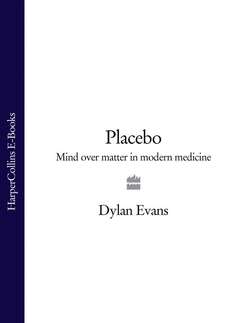Читать книгу Placebo: Mind over Matter in Modern Medicine - Dylan Evans - Страница 19
NATURAL BORN PAINKILLERS
Оглавление‘To talk about placebos,’ writes the American gastroenterologist Howard Spiro, ‘is to talk in large part about pain.’5 Of all the claims made for the placebo response, those that emphasise its power to relieve pain are the most well-established. The pioneers of placebo research focused almost exclusively on the painkilling properties of placebos. Most of the studies conducted by Beecher, Lasagna and others in the late 1940s and early 1950s were marred, however, by their failure to include no-treatment groups. Typically, they would report that a certain number of patients experienced pain relief after being given a placebo, and conclude that this had been caused by the placebo. This conclusion cannot be trusted, since no attempt was made to measure the spontaneous improvement in patients who did not receive a placebo.
Fortunately, more recent studies of placebo analgesia have included no-treatment control groups in addition to the experimental group and the placebo group. In most of these studies, the no-treatment group has been found to do significantly worse than both the experimental and the placebo groups. We can be confident, then, that the pain reduction experienced by those given the placebo would not simply have happened anyway. Placebo analgesia is real.
In a particularly striking study, patients who had undergone tooth extraction were treated with ultrasound to reduce the postoperative pain.6 Unknown to both doctors and patients, the experimenters had fiddled with the machine, and half the patients never received the ultrasound. Since ultrasound consists of sound waves of very high frequency – so high, in fact, that they are inaudible to the human ear – there was no way for the doctors or the patients to tell whether or not the machine was emitting the sound waves; the test was truly double-blind. After their jaws were massaged with the ultrasound applicator, the patients were asked to indicate their level of pain on a line where one end was labelled ‘no pain’ and the other ‘unbearable pain’. Compared with the untreated control group, all those treated with the ultrasound machine reported a significant reduction in pain. Surprisingly, it didn’t seem to matter whether the machine had been switched on or not. Those who had been massaged with the machine while it was turned off showed the same level of pain reduction as those who had received the proper treatment. In fact, when the ultrasound machine was turned up high, it was actually reported as giving less pain relief than when it was switched off.
We cannot be absolutely sure, even with this model study, that the greater relief experienced by those receiving the fake ultrasound, compared to those receiving no treatment, was due entirely to the placebo effect. Before the switched-off ultrasound machine was applied to the patient’s jaw, a coupling cream was rubbed on the skin around it, and this may have reduced the postoperative swelling by itself. Another study examined this possibility by including a control group of patients who were instructed to apply the facial massage, including the cream, to themselves.7 No reduction in the pain or swelling occurred in this group. The reduction in swelling could not, therefore, have been due to either the massage or the cream. It must have been due to the placebo effect.
Another study to include a no-treatment group compared the placebo response with the powerful painkilling drug buprenorphine.8 Fifty-seven patients with lung cancer who had undergone the notoriously painful operation of thoracotomoy (surgical opening of the chest cavity) and lobectomy (removal of part of the lung) were given injections of buprenorphine at thirty-minute intervals until the pain was adequately reduced. The next day, when their pain had returned to a high level, some of the patients were injected with salt water, while the rest were given no treatment at all. Those who received the saline injection experienced a significant decrease in pain over the following hour, while the pain level of the no-treatment group actually increased during the same period. Once again, the body had been encouraged by a pharmacologically inert substance to suppress its own pain.
